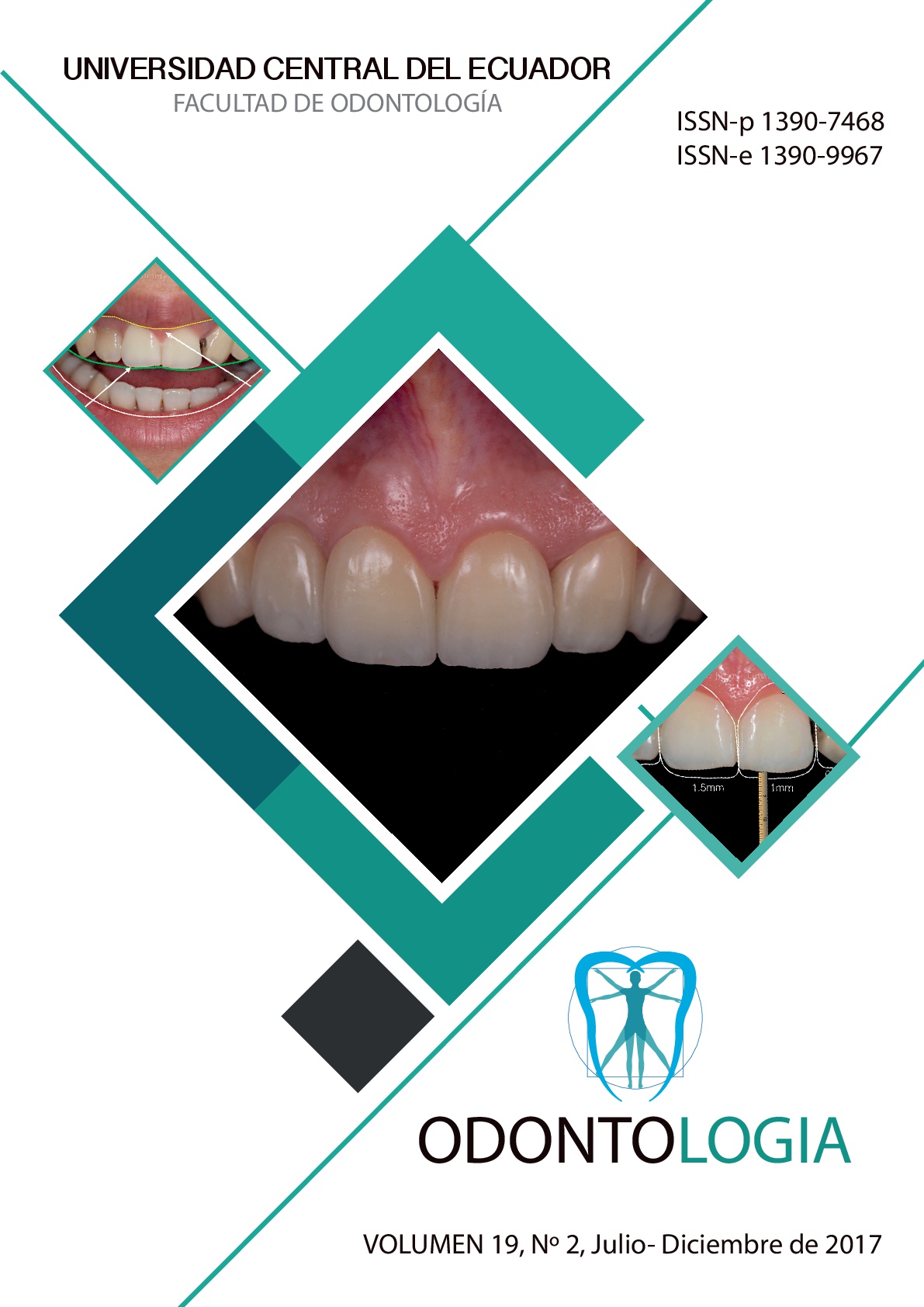Efeito antifúngico de diferentes concentrações hidroalcoólicas de Uncaria Tomentosa em Candida albicans: Estudo in vitro
DOI:
https://doi.org/10.29166/odontología.vol19.n2.30-39Keywords:
Uña de Gato (cat’s claw), Oral health, Mycosis, Medicinal plantsAbstract
At present, the use of phytotherapy is in greater demand by patients and many health professionals due to its easy access, low cost and because of adverse reactions. Objective: To determine the antifungal effect of different hydroalcoholic concentrations of Uncaria tomentosa (UT) about Candida albicans ATCC 10231, Materials and methods: In vitro experimental study. The sample consisted of 24 box of petri dishes with Sabourand agar, each with six discs corresponding to the 6 study groups being: G1 Nistatin 21 ul (Positive Control); G2 hydroalcoholic extract of 100% UT; G3 hydroalcoholic extract of 75% UT; G4 hydroalcoholic extract of 50% UT; G5 hydroalcoholic extract of 25% UT; G6 70 ° Ethyl Alcohol (Negative Control) A hydroalcoholic extract was elaborated by maceration, using 75mg of micropulverized plant and 250ml of ethyl alcohol of 70 °, 150ml of extract was obtained, the same one that was diluted to obtain three secondary concentrations at 75%, 50% and 25%. The data were processed and analyzed through the ANOVA and Bonferroni test with a level of significance of 5%. Results: A halo of inhibition of 6.46 mm, 10.96 mm, 14.75 mm and 16.5 mm was observed for the hydroalcoholic extracts at 25%, 50%, 75% and 100% respectively. Nistatin showed a halo of inhibition of 23.42 mm and ethyl alcohol of 70 ° did not have any antifungal effect. A statistically significant difference was observed between the groups (<0.001). Conclusion: The 100% hydroalcoholic extract of UT such as nystatin showed to be sensitive, while the concentrations at 50% and 75% showed intermediate sensitivity and the concentration at 25% was resistant against Candida albicans.
Downloads
References
OMS.who.int.[Online].; Farmacoresistencia. Importancia de la resistencia a los antimicrobianos para la salud pública. 2016 [cited 2016. Available from: http://www.who.int/drugresistance/AMR_Importance/es/.
Souza-Júnior UP, Pereira JV, Pereira MSV, Costa MRM, Pereira AV, Antunnes RMP. Atividade Antifúngica In Vitro do Extracto da Uncaria Tomentosa L. (Unha De Gato) sobre Cepas do Genero Candida. Pesq Bras Odontoped Clin Integr, João Pessoa. 2011; 11(4): 477-80.
Negroni M. Microbiología Estomatológica, Fundamentos y guía práctica. Buenos Aires: Editorial Médica Panamericana S.A.; 2009.
Marsh PD. Microbiología Oral Venezuela: Amolca; 2011.
Kleinegger CL, Stoeckel DC, Kurago ZB. A comparison of salivary calprotectin levels in subjects whit and without oral candidiasis.Oral Surg Oral Med Oral Pathol Oral Radiol Endod. 2001; 92(1): 62-7.
Paiva LCA, Ribeiro RA, Pereira JV, Oliveira NMC. Avaliação clínica e laboratorial do gel da Uncaria tomentosa (Unha de Gato) sobre candidose oral. Rev bras farmacogn. 2009; 19(2A): 423-28.
Guggenheimer J, Moore P, Rossie K, Myers D, Mongelluzzo MB, Block HM, Weyant R, Orchard T. Insulin-dependent diabetes mellitus and oral soft tissue pathologies. I.Prevalence and characteristics of non-candidal lesions. Oral Surg Oral Med Oral Pathol Oral Radiol Endod. 2000; 89(5): 563-9.
Silva MRR, Paula CR, Silva SC, Costa TR, Costa MR. Drug resistance of yeasts isolated from oropharyngeal candidiasis in aids patients. Rev Microbiol. 1998; 29(4): 271-5.
Ccahuana-Vasquez RA, Santos SSF, Koga-Ito CY, Jorge AOC. Antimicrobial activity of Uncaria Tomentosa against oral human pathogens. Braz Oral Res. 2007; 21(1): 46-50.
Obregón Vilches L. Uña de gato. Género Uncaria. Estudios botánicos, químicos y farmacologicos de la Uncaria tomentosa y Uncaria guianensis. Lima: Instituto de fitoterapia Americano; 1996.
Santa María A, Lopez A, Diaz MM, Alban J, Galan de Mera A, Vicente Orellana JA et al. Evaluation of the toxicity of Uncaria tomentosa by bioassays in vitro. J Ethnopharmacol. 1997; 57(3):183-7.
Ceballos AS, Gaitán LAC, Orihuela FC, Olea DB, Ceballos LG, Quindós G. Resistencia in vitro a los antifúngicos en Candida albicans de pacientes infectados por el VIH con y sin candidosis oral. Rev Iberoam Micol. 1999; 16:194-97.
Elliot J, Hilario R. Néctares y macerados enriquecidos con uña de gato Lima: ITDG- Perú.; 2002.
Herrera DR, Tay LY, Rezende EC, Kozlowski VA, Santos EB. In vitro antimicrobial activity of phytotherapic Uncaria tomentosa against endodontic pathogens. J Oral Sci. 2010; 52(3): 473-6.
Silva D, Alvarado D, Hidalgo H, Cerrutti S, Garcia R, Dávila M. Monografia de Uncaria tomentosa (Willd.) Iquitos: Instituto Peruano de Seguridad Social/Instituto de Medicina Tradicional; 1998.
White G, Bourbonnais-Spear N, Garner F. Antibacterial Constituents from Uncaria tomentosa. Phytopharmacol. 2011: 16-19.


